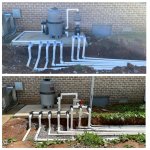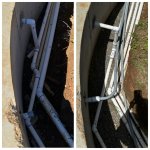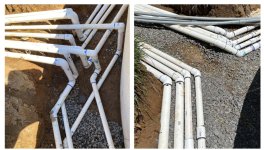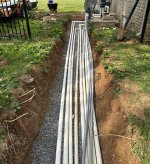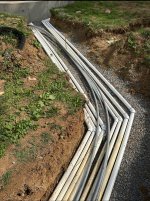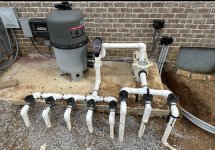It is fine to use equivalent length of pipe when estimating head loss in the pipe and fittings but this is NOT the same as head loss. It just gets you one step closer. You then need to calculate the head loss at a specific flow rate BUT that too is not really correct because you need to find the crossover between the pump's head curve and the plumbing head curve. My first estimate for your plumbing head curve is:
Head (ft) = 0.004 * GPM^2
Note that this has a head loss of 40' at 100 GPM but if you use your 150 GPM goal, the head loss becomes 90' of head. Double what you calculated. This of course is not on the Intelliflo's head curve as I showed above. This is why you must use a plumbing curve to determine the actual operating point.
If you plot the plumbing curve over the pump's head curve, where they cross is the operation point which I showed in my previous post. But I did not have your fitting count so it may be slightly off.
I am having a hard time figuring out what you exactly what you did to see where you went wrong. What was your total equivalent length of pipe and what was the GPM that used to determine head loss?
How did you treat the parallel pipe vs the series pipe? Head loss adds with pipe in series. However, when pipe is in parallel, it is much more complicated. The head loss in each pipe must be the same because they share the same input and the same output node. Also, the total flow rate splits into the separate pipes so the resulting head loss is less than if a single pipe carries all of the flow.
Also, a swimming pool "rise" only occurs for water falls and slides. The rest of the plumbing has no rise as it is canceled out by an equal fall.
Also, everything that touches the water adds head loss so skimmers, MDs, eyeballs, exit pipe etc. I don't see these in your calculations.
As I said before, this is not a trivial calculation.
If I get some time, I will update my calculation with your fitting counts.
Whoa! Ok. I understand the graph you made much better now.
I used 70 GPMs in calculations (as the blog gave predetermined equivalent feet for that flow), and I didn’t account for series or parallel. 2 returns are in series on the left and 2 on the right. 1.5” all the way. Everything else unaccounted for was because I didn’t have that data or know the equations to determine.
I just realized that I only estimated feet of head for the suction side!


